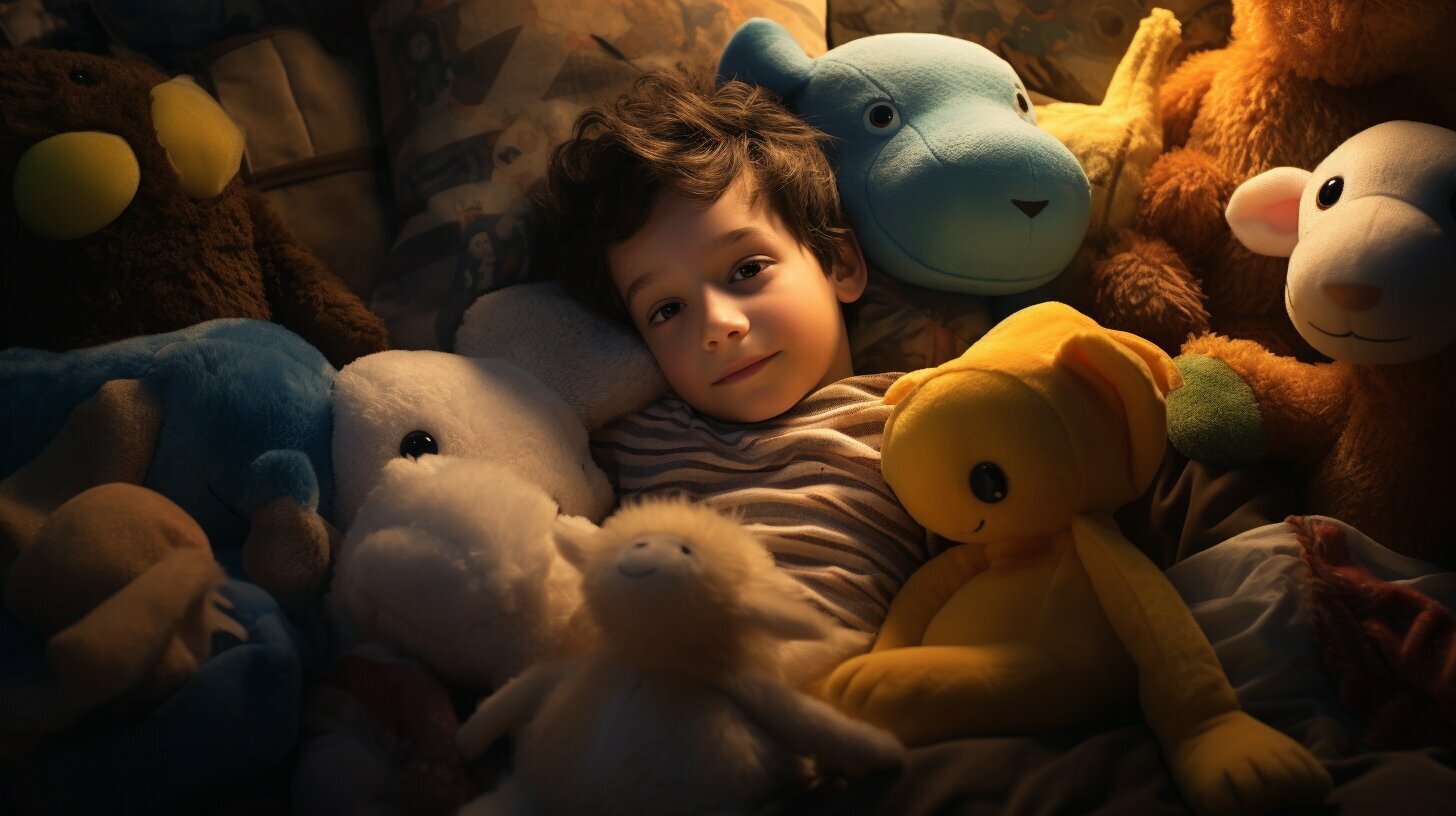You’re not alone if you’ve ever wondered why your child sleeps on the floor. Many parents find themselves perplexed by this behaviour, but there are several valid reasons why a child may prefer the floor over their bed.
Toddlers may choose to sleep on the floor for various reasons. Some find it more comfortable than their bed because of its firm support.
Others may feel more secure and grounded when sleeping closer to the ground. Some toddlers enjoy the sensory experience of different textures like carpet or hardwood floors.
Allowing your child to sleep on the floor can promote their independence and give them control over their sleeping preferences.
However, there are potential safety hazzards to consider, such as tripping or falling out of bed, and it may be more difficult to transition them back to a bed later on.
Dressing your toddler in warm clothing and creating a safe sleeping environment by removing potential hazzards and securing cords is essential.
Consulting with a pediatric sleep consultant or physician can provide further guidance.

Important Points To Consider:
- Many children may sleep on the floor for comfort, security, and sensory stimulation.
- Allowing your child to sleep on the floor can promote their independence and sense of control.
- Safety considerations should be considered, such as removing potential hazzards and securing cords.
- Transitioning a child back to bed may require patience and strategies to encourage healthier sleep habits.
- Dressing your child appropriately for floor sleeping can help regulate their body temperature at night.
Comfort and Support
Some children find the floor more comfortable than their bed, thanks to the firm support it offers. For these children, lying directly on a solid surface can promote better sleep and a sense of security.
The firmness of the floor provides a stable foundation that some toddlers prefer over the softness of a mattress. It can also mimic the feeling of being held or hugged, which can be soothing for them.
When a child chooses to sleep on the floor, ensuring their comfort and support is essential. Placing a soft rug or cushioning under their sleeping area can provide additional padding and insulation from the cold floor. This can help create a cosy and inviting space for them to rest.
The Importance of a Sleep Environment
The sleep environment plays a crucial role in promoting healthy sleep habits for children. It is important to create a safe and comfortable space that meets their individual needs.
By understanding why your child prefers the floor, you can adjust their sleep environment to cater to their unique preferences.
Children have different sleep patterns and behaviors. It is essential to respect their choices and find ways to support their sleeping preferences while ensuring their safety.
Providing a supportive sleep surface is integral to creating a beneficial sleep environment. By recognising and accommodating your child’s preference for the floor, you can help them establish a positive sleep routine that promotes a restful night’s sleep and overall well-being.
Advantages And Disadvantages Of Sleeping On The Floor
| Pros | Cons |
|---|---|
| Provides firm support | Potential safety hazzards |
| Comforting and secure feeling | Difficult transitioning back to a bed |
| Can mimic the sensation of being held or hugged | Requires adjustments to create a safe sleeping environment |
While some children may prefer sleeping on the floor, balancing their comfort and safety is vital.
Regularly reassessing their sleep environment and consulting with a pediatric sleep consultant or physician can provide further guidance on promoting healthy sleep habits for your child.
Grounded Feeling
For some children, sleeping closer to the ground provides an enhanced feeling of being grounded, which can create a sense of comfort and security. This desire for stability may be one of the reasons why your child chooses the floor over their bed.
Children can experience a unique sense of physical and emotional grounding when sleeping on the floor.
The proximity to the ground gives them a feeling of stability as if they are rooted in their sleeping space. This can provide comfort and security, especially for children who crave a stable and controlled environment.
The grounded feeling associated with floor sleeping can also be attributed to the sensory experience it offers.
Different textures, such as carpet or hardwood floors, can have a soothing effect on some children. The tactile sensations they experience can contribute to their overall well-being and relaxation, making the floor a more appealing sleeping surface.
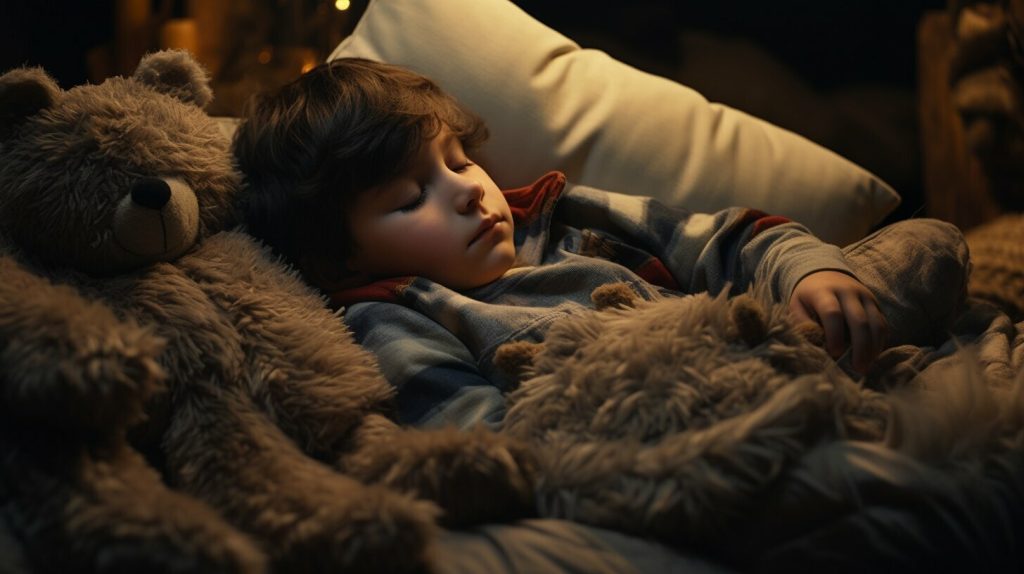
Transitioning your child to sleep in bed may pose challenges later. It is advisable to consult with a pediatric sleep consultant or physician for guidance on promoting safe and healthy sleep habits.
The desire for a grounded feeling, comfort, and sensory experience are reasons why children may choose to sleep on the floor.
While this sleeping preference can foster a sense of independence and control, it is crucial to prioritize safety and create a safe sleeping environment for your child.
Sensory Experience
The sensory experience of sleeping on the floor can be enticing for some children. The different textures, such as the softness of a carpet or the coolness of a hardwood floor, can provide a unique tactile experience that appeals to their senses.
The floor may offer a comforting and soothing environment for children with a heightened sensitivity to touch, promoting better sleep.
When a child sleeps on the floor, they can feel more connected to their surroundings. The close proximity to the ground can create a sense of stability and grounding, which can help them feel more secure and at ease.
This sense of physical and emotional grounding can improve some children’s sleep experience.
However, it’s important to note that while floor sleeping may have sensory benefits, ensuring your child’s safety and well-being is crucial.
As a parent, you need to create a safe sleep environment by removing potential hazzards and securing cords that could pose a risk.
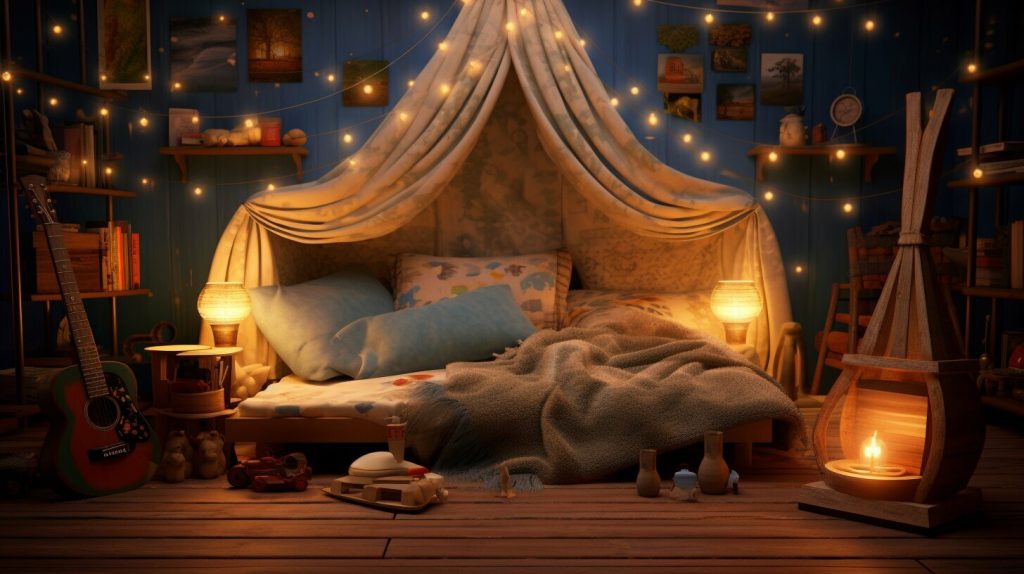
Sensory Experience and Sleep Environment
Creating a sleep environment that caters to your child’s sensory needs is essential. Consider incorporating sensory elements into their bedroom, such as soft blankets, cosy pillows, and soothing lighting.
Providing a variety of textures and materials can enhance the sensory experience and help your child feel more comfortable and relaxed.
Additionally, you can encourage sensory exploration during playtime to help regulate your child’s sensory system and promote better sleep.
Engaging in activities that stimulate their senses, such as playing with sensory bins or engaging in tactile play, can help your child unwind and prepare their body for sleep.
Remember, every child is unique, and their sleep preferences may vary. By understanding and respecting your child’s sensory needs and preferences, you can create a sleep environment that supports their overall well-being and promotes restful nights of sleep.
Independence and Control
Allowing your child to sleep on the floor gives them a sense of independence and control over their sleep environment.
By giving them the freedom to choose where they sleep, you empower them to decide about their comfort.
Many toddlers enjoy the autonomy of selecting their sleeping spot, whether on a soft carpet or a cool hardwood floor. The floor provides them with a familiar and comforting space where they can establish their own sleeping routine.
Pediatric sleep experts say this sense of independence can benefit a child’s development. It allows them to explore and understand their physical and emotional preferences.
By respecting their choice to sleep on the floor, you are fostering their autonomy and teaching them to listen to their own body and needs. This can have positive effects on their overall sleep habits and self-confidence.
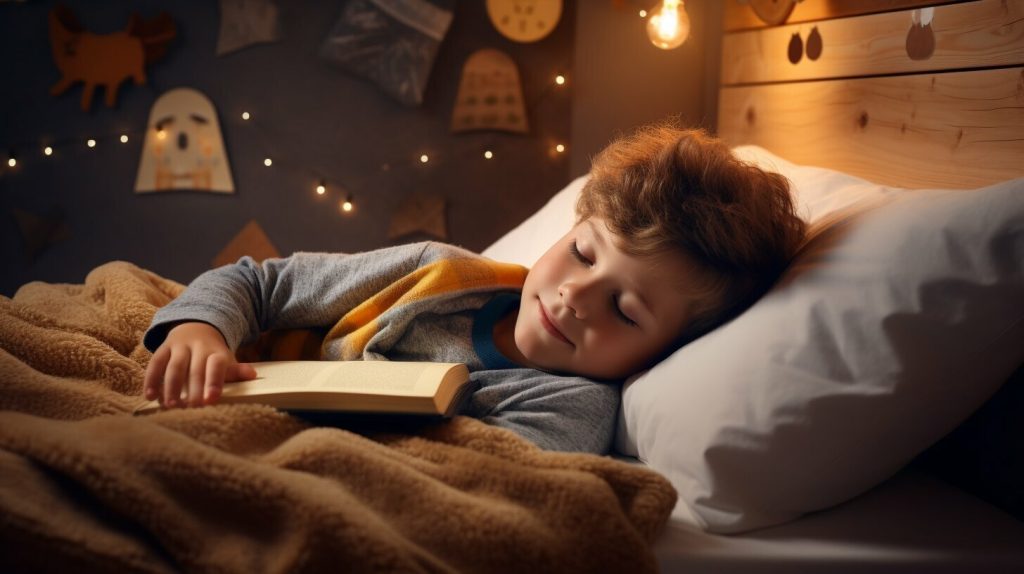
Promoting Healthy Sleep Habits
While allowing your child to sleep on the floor can be seen as a positive way to encourage independence, ensuring their safety and well-being is crucial.
It would be best if you created a safe sleeping environment by removing any potential hazzards like loose cords or sharp objects. It’s also crucial to dress your child in warm and comfortable clothing to regulate their body temperature throughout the night.
Transitioning your child back to sleeping on a bed may pose some challenges. To make the transition smoother, you can gradually introduce the idea of sleeping in a bed by incorporating familiar elements like their favourite blanket or stuffed animal.
Offering reassurance and understanding during this adjustment period can help them feel secure and supported.
In summary
- Allowing your child to sleep on the floor promotes independence and control over their sleep environment.
- Ensure their safety by removing potential hazzards and dressing them in warm clothing.
- Transitioning back to a bed may require patience and gradual adjustment.
- Consult with a pediatric sleep consultant or physician for further guidance.
Every child is unique, and their sleep preferences may change over time. By understanding and respecting their choices, you can support their healthy sleep habits and overall well-being.
Safety Considerations
While floor sleeping can have benefits, it’s essential to consider safety precautions.
To create a safe sleeping environment for your child, start by ensuring the floor is clear of any obstacles or clutter, such as toys or loose wires.
Secure cords from blinds or curtains so they are out of reach and can’t pose a risk of strangulation. Consider using a soft, padded floor mat or blanket to provide extra cushioning and protection against bumps or bruises.
| Child Sleep Patterns | Floor Sleeping Solutions |
|---|---|
| Stick to a consistent bedtime routine to help your child develop a sense of security and sleepiness. | Place a bed rail or cushion along the edge of the floor to prevent accidental falls. |
| Keep the room temperature comfortable and maintain proper ventilation to ensure your child sleeps soundly. | Use non-slip rugs or mats to prevent slipping and sliding on smooth flooring surfaces. |
| Avoid using loose bedding, such as blankets or pillows, which can increase the risk of suffocation. | Opt for low-profile furniture that won’t be a hazard if your child rolls off the floor during sleep. |
Additionally, it’s important to consult with a pediatric sleep consultant or physician if you have concerns about your child’s sleep patterns or floor sleeping habits.
They can provide further guidance and help you navigate any challenges or transitions that may arise.
Transitioning Back to a Bed
Transitioning your child from floor sleeping back to a bed can be a gradual process that requires patience and consistency. I will explore techniques to reintroduce the bed as their primary sleep surface gently.
One approach is to create a cosy and inviting sleep environment on the bed. Start by placing their favourite stuffed animals or blankets on the bed to make it feel comforting and familiar.
You can also use a mattress topper to provide a similar level of firmness to what they experienced on the floor.
Another strategy is to involve your child in the transition process. Allow them to choose new bedding or pillows that they find appealing. This sense of ownership can empower them and make the bed more inviting.
Consistency is key during this transition. Stick to a consistent bedtime routine and reinforce the idea that the bed is where they should sleep. If they try to return to the floor, calmly guide them back to their bed and provide reassurance.
Over time, they will associate the bed with sleep and feel more comfortable sleeping in it.
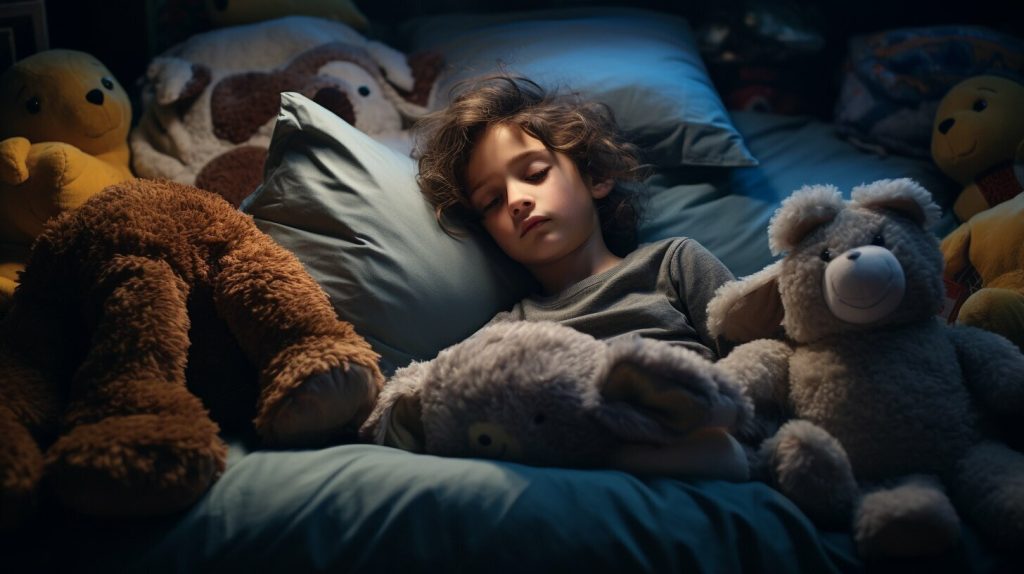
Expert Tip
Consulting with a pediatric sleep consultant or physician can provide further guidance tailored to your child’s specific needs and sleep patterns.
| Techniques for Transitioning Back to a Bed | Benefits |
|---|---|
| Creating a cosy sleep environment on the bed | – Makes the bed feel comforting and inviting |
| Involving your child in the transition process | – Empowers them and increases their sense of ownership |
| Consistency in the bedtime routine | – Reinforces the idea that the bed is for sleeping |
Every child is unique, and the transition process may take time. Be patient and supportive as you guide your child to sleep in a bed. With consistency and gentle encouragement, they will gradually adjust to their new sleep arrangement and develop healthier sleep habits.
Dressing for Comfort
When your child sleeps on the floor, it’s essential to ensure they are dressed in appropriate sleepwear to maintain comfort throughout the night. I will discuss the importance of choosing breathable fabrics and layers for optimal temperature regulation.
To promote healthy sleep habits, it is essential to consider the type of sleepwear your child is wearing when they choose to sleep on the floor.
Opting for breathable fabrics such as cotton can help regulate their body temperature, preventing overheating or excessive sweating, which may disrupt their sleep. Layering their sleepwear can also offer flexibility as they may feel too hot or cold throughout the night.

| Benefits of Choosing Appropriate Sleepwear |
|---|
| Temperature Regulation |
| Choosing sleepwear made from breathable materials helps maintain a comfortable body temperature throughout the night. |
| Comfort and Mobility |
| Well-fitting sleepwear allows your child to move freely and sleep without any restrictions or discomfort. |
| Quality Sleep |
| Appropriate sleepwear promotes better sleep quality, ensuring your child wakes up refreshed and energized. |
It is also important to consider the season and room temperature when selecting sleepwear. During colder months, you can add layers such as a lightweight cardigan or sleep sack to provide extra warmth.
In warmer weather, opt for lightweight and breathable materials to prevent overheating.
When your child chooses to sleep on the floor, it is crucial to dress them in appropriate sleepwear for their comfort.
Choosing breathable fabrics and layering their sleepwear can help regulate their body temperature and promote restful sleep.
Remember to consider the season and room temperature when selecting sleepwear to ensure your child’s optimal comfort throughout the night.
Creating a Safe Sleeping Environment
It’s crucial to create a safe sleeping environment for your child, whether on the floor or in a bed. I will explore how to identify and remove potential hazzards that could threaten their safety.
One of the first steps in creating a safe sleep space is to ensure the area is clutter-free. Remove objects or furniture that could be tripping hazzards, such as toys, shoes, or loose cords.
It’s also essential to secure any cords from blinds or curtains within your child’s reach.
Use cord cleats or winders to keep the cords out of their reach, or consider using cordless window coverings.
Another important aspect of a safe sleep environment is ensuring a well-maintained and supportive floor surface. If your child sleeps on a carpeted floor, regularly vacuuming and keeping it clean will help prevent dust mites and allergens from accumulating.
Consider using non-slip rugs or mats for hardwood or tiled floors to provide comfort and safety. Avoid placing rugs or mats near their bed area to reduce the risk of tripping or slipping.
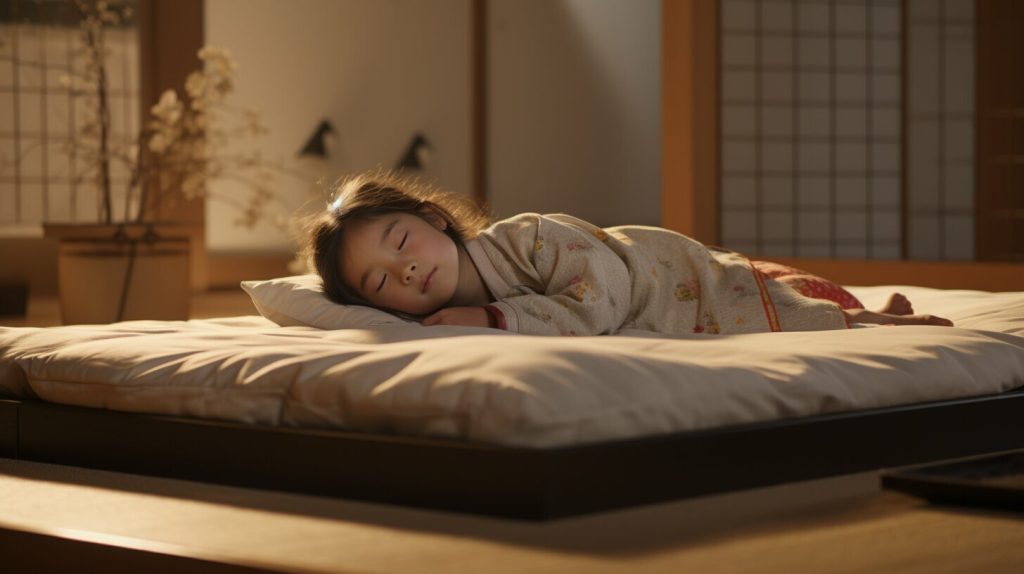
It’s also essential to consider temperature control in your child’s sleep environment. Keep the room comfortable, preferably between 68-72 degrees Fahrenheit (20-22 degrees Celsius).
Please dress your child in appropriate sleepwear that will keep them warm without overheating. Avoid using heavy blankets or pillows, as these can pose suffocation risks.
| Potential Hazards | Prevention Tips |
|---|---|
| Tripping or falling out of bed | Install bed rails or use a low-profile bed frame |
| Electrical outlets | Use outlet covers or secure outlets with furniture |
| Window falls | Install window guards or keep windows locked |
| Strangulation hazards | Secure cords from blinds or curtains out of reach |
If you have concerns about your child’s sleeping habits or safety, consulting with a pediatric sleep consultant or physician can provide further guidance.
They can help address any specific challenges you may be facing and offer tailored solutions to ensure your child’s sleep environment is both safe and comfortable.
Final Thoughts
Understanding why your child sleeps on the floor can help you navigate this behaviour and make informed decisions about their sleep environment.
Considering their comfort, preferences, and safety, you can encourage healthier sleep habits that benefit you and your child.
Toddlers may choose to sleep on the floor for various reasons. Some find it more comfortable than their bed because of its firm support.
Others may feel more secure and grounded when sleeping closer to the ground. Some toddlers enjoy the sensory experience of different textures like carpet or hardwood floors.
Allowing your child to sleep on the floor can promote their independence and give them control over their sleeping preferences.
However, it is essential to be mindful of potential safety hazards, such as tripping or falling out of bed, that may arise when your child sleeps on the floor. Additionally, transitioning them back to a bed later could be more challenging.
To mitigate these risks, dress your toddler in warm clothing to regulate their body temperature during the night.
Furthermore, create a safe sleep environment by removing potential hazards and securing cords.
Consulting a pediatric sleep consultant or physician may be helpful if you are still unsure how to manage your child’s floor sleeping habits.
These professionals can provide further guidance tailored to your child’s needs and circumstances. By addressing any concerns and implementing appropriate strategies, you can support your child’s sleep and overall well-being.
FAQs
Q: Why does my child sleep on the floor?
A: There can be various reasons why a child may choose to sleep on the floor. Some find it more comfortable due to its firm support, while others may feel more secure and grounded closer to the ground.
Additionally, some children enjoy the sensory experience of different textures like carpet or hardwood floors. Allowing your child to sleep on the floor can promote their independence and give them control over their sleeping preferences.
Q: What are the potential safety hazards when my child sleeps on the floor?
A: When your child chooses to sleep on the floor, there are potential safety hazards such as tripping or falling out of bed. It may also be more difficult to transition them back to a bed later on.
Creating a safe sleeping environment is important by removing potential hazards and securing cords. Consulting with a pediatric sleep consultant or physician can provide further guidance on ensuring safety.
Q: How can I dress my child appropriately for floor sleeping?
A: Dressing your child in warm and comfortable clothing is essential when they sleep on the floor. Choose sleepwear that will help regulate their body temperature during the night and provide optimal comfort. This can include items such as pyjamas or sleep sacks.
Q: How can I create a safe environment for my child when they sleep on the floor?
A: To create a safe sleeping environment for your child on the floor, it is important to remove potential hazards, such as loose cords or objects that may cause tripping. Ensure the area is clear and secure to minimize accidents.
Additionally, it would be best to ensure the floor is clean and free of any sharp or uncomfortable objects that may disrupt their sleep.
Q: How can I transition my child from sleeping on the floor to a bed?
A: Transitioning a child who sleeps on the floor back to a bed can be challenging. You can start by gradually reintroducing the bed and encouraging them to spend more time in it.
Creating a positive and inviting sleep environment in their bed can also help. It may be helpful to consult a pediatric sleep consultant or physician for specific strategies tailored to your child.
